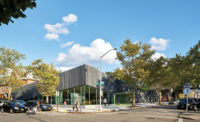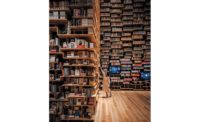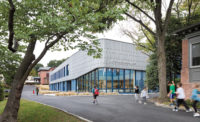Many people imagine Japan as either dazzlingly active, like Tokyo, or charmingly traditional, like Kyoto. But much of the country is dotted with doughnut cities where once thriving downtowns have been supplanted by suburban shopping malls, and pedestrian traffic is practically nonexistent. Keen to counter this condition in their community, the citizens of Ota, a city of 220,000 located 75 miles northwest of Tokyo, asked their mayor to intervene. The problem wasn’t just bringing people back into town—over 10,000 travelers use the central train station daily—it was getting them to stay. The mayor responded by hosting an open competition for a combined gallery and library next to this transit hub. The building proposed by Tokyo architect Akihisa Hirata (Design Vanguard 2013) turned out to be just the ticket. From afar, its hill-shaped form echoes the ancient kofun burial mound off in the distance. But, up close, its cluster of window-walled boxes teems with activity. Part cultural mecca, part information exchange, and part community center, Hirata’s building has clearly become Ota’s “it” place.
Additional Content:
Jump to credits & specifications
Picking up where the city leaves off, the scheme is urban in character, yet the architect’s organic form and white steel frame intentionally contrast sharply with the rows of shuttered shopfronts nearby. Fitting in is rarely a concern when it comes to new construction in Japan, especially in a location needing invigoration. The eccentric structure is entered from multiple directions. It consists of five building-like boxes wrapped by glass walls, laced together with ramped paths that connect floor levels. Quoting from the cityscape outside, round traffic mirrors and neon signage help navigate the way.
Instead of putting the two primary functions of reading and exhibition space inside individual cubes or stratifying them horizontally, Hirata mixed their components together—a solution reached after several community workshops initiated by the architect. “This [decision-making process] was much clearer for us than just imagining how we would use the place,” remarks Hirata. At grade, the clover-shaped footprint containing the individual boxes holds a café, double-height gallery, magazine and newspaper corner, and administrative areas. The second floor also contains a gallery plus separate spaces for children’s and art books. An audiovisual hall, another gallery, and the library’s reference room occupy the third floor. While terraces loop around parts of the perimeter at each floor, roof gardens top each box.
Though divided into three stories, the new development contains upward of 15 different levels. “I didn’t want a clear division between floors,” explains Hirata. He achieved this by varying the floor heights within the boxes and incorporating, or attaching, flat areas to the sloped circulatory system. In some places, the ramps morph into informal seating and study areas. Elsewhere, they open onto the terraces. From there, the sloped walk ascends to the roof, forming a continuous circulation loop that connects interior to exterior and top to bottom.
Angled on a code-sanctioned 1:12 slope, the interior ramps are accessible everywhere except between the second and third floor, where Hirata swapped in broad steps. Doubling as informal seating, the stairs enliven the path but require wheelchair users to take the elevator in order to reach the top or bottom of the stairs. Located in the middle of the building, elevators can streamline the ascent or descent. But that’s missing the point. This is an architecture that promotes discovery and sparks chance encounters. Instead of simply going up, down, or across, one meanders through this building, pausing to gaze at the distant mountains or glimpse children playing below. In a public building especially, it is unfortunate that this experience is not fully accessible due to the one set of giant stairs.
In contrast to the ramps’ sense of movement, the boxes themselves are inherently static. Each blocky volume is made of concrete, coated with white paint, and reinforced with a hidden steel frame. Spaced 10 feet apart, the frames’ vertical elements support the steel beams beneath the walkway as it winds its way up and around the building. Doubling as window sashes, slender columns prop up the ramps’ outer edges. Because the boxes stand independently, they could be arranged freely—an attribute that the architect exploited fully. Guided by function, they angle this way and that, adding to the building’s dynamism. Though there is no explicit front or back, the building steps up from the train station on one side, enticing travelers to stop in for a latte or a glance at the latest headlines. It crests at the top-floor audiovisual hall, fittingly used by both the library and museum.
More kunsthalle than bona fide museum, the building features temporary exhibits. Treated like blank canvases, the galleries’ white walls and concrete floors can accommodate installations of various sorts, but the library rooms contain a variety of finishes and furnishings that imbue each one with a distinct character. While William Morris wallpaper helps soften the children’s reading corner, a custom chandelier is a focal point of the research room. Like the library’s upholstered seating elements, the unique, metal-framed light fixture was a collaboration with a local factory that supplies parts to Subaru, the carmaker whose manufacturing division is headquartered in Ota.
Because of its auto industry, the city is neither lacking in revenue nor plagued by a dwindling population. What it does need is revitalization of its dilapidated downtown. A public works development in the best sense of the word and an example of architecture that prioritizes engagement, the Ota Museum & Library could be the grain of sand that starts the pearl growing in the oyster that is the town’s center.
CreditsArchitect: Akihisa Hirata Architecture Office — Akihisa Hirata, principal; Yuko
Engineers: Arup (structural, environmental)
Consultants: Izumi Okayasu Lighting Design Office (lighting); Atsushi Hirano/AFFORDANCE (signage, wayfinding); SfG (landscape)
Client: Mayor of the City of Ota |
SpecificationsLight Fixtures Fuji Heavy Industries; AI-LAB
Glass NSG
Textiles Yoko Ando Design
Furniture Minerva
Lightweight Soil Ikegami |















Post a comment to this article
Report Abusive Comment